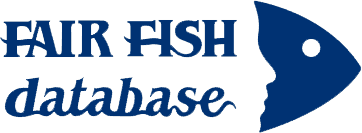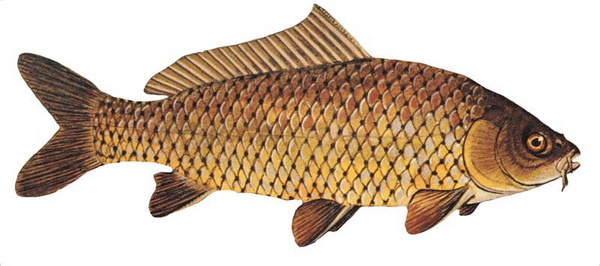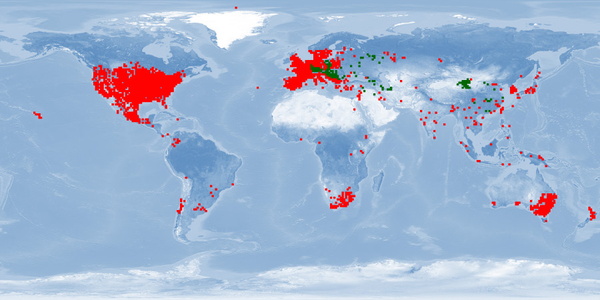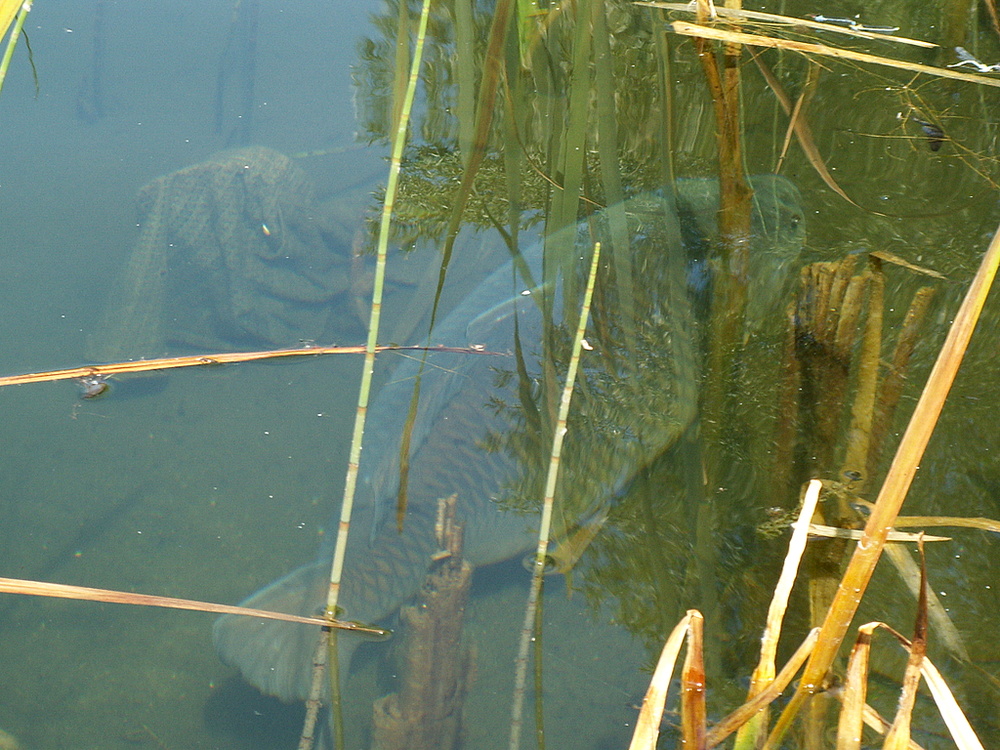Information
Version: B | 1.2 (2023-07-26)
B | 1.2 (2023-07-26)
link corrections
Changelog
1 Overview
2 General
- Escapes: rear only in environments where it naturally occurs D1 and prevent escapes. Else, escapees from fish farms have negative or at most unpredictable influences on the local ecosystem D2. Prepare for sexual maturity (and thus spawning) from 2-3 years or 289-312 mm on for males and 2-3 years or 312-356 mm on for females D3 and take measures against spawning into the wild.
3 Designing the (artificial) habitat
3.1 Substrate and/or shelter
- Substrate:
- Shelter or cover:
- Cover: avoid complete cover in respect for differences in the daily rhythms A3.
- Vegetation: ➝ Shelters.
- Shelters: in the wild, fry were observed among vegetation, not in open water D5. In the laboratory, juveniles used plants as shelters D6. For the most natural solution, provide vegetation; alternatively, provide artificial shelters inside the system or outside.
3.2 Photoperiod
- Photoperiod: given the distribution D1 D7, natural photoperiod is 7-17 hours, depending on the season. Provide access to natural (or at least simulated) photoperiod and daylight.
- Light intensity: for lower stress and higher weigth in juveniles, prefer 200 over 80 lux, although the growth effect might be due to additional music played D8 D9. Further research needed.
- Light colour: no ethology-based recommendation definable so far.
- Resting period: allow Common carp a resting period at night or in the dark D10.
3.3 Water parameters
- Temperature: no clear temperature preference, for highest growth best kept at 20-28 °C D11 D12. Above may mean lower survival, but it depends on age and rate of temperature change D13. Adjust temperature when you notice avoidance behaviour D14 D15.
Implemented in aquaculture, temperatures >22 °C demand excellent oxygen levels and a fine-tuned flow-through system to prevent bacterial load.
For temperature and spawning ➝ A1. - Water velocity: no ethology-based recommendation definable so far.
- Oxygen: maintain oxygen level that ensures welfare depending on temperature (➝ Temperature) and stocking density (➝ A4).
- Salinity: given the potamodromous migration type, natural salinity is at freshwater level from egg to adult stage D16 D17.
- pH: no ethology-based recommendation definable so far.
- Turbidity: in the wild, lives in oligo- to eutrophic lakes, water transparency is at 5-49 cm Secchi depth D18. For the most natural solution, maintain turbidity at this range. Further research needed.
3.4 Swimming space (distance, depth)
- Distance: in the wild, remains in home range of 10-70 m, but individuals differ in number of long-term movements of up to 600 m or in areas of up to 10.6 km D19. Further research needed. Individual differences in activity D20. Further research needed. Provide at least 10-70 m, bearing in mind the planned stocking density A4.
- Depth:
- Depth range: in the wild, found at 0-1.3 m, adults up to 25 m D15. Provide at least 1.5 m, ideally up to 5 m or more, bearing in mind the planned stocking density A4. Individuals should be able to choose swimming depths according to life stage D15.
For depth and spawning ➝ A1. - Flight: no ethology-based recommendation definable so far.
- Temperature layers: in habitats with water layers with different temperatures, prepare for individuals migrating to layers with preferred temperatures D11 D15, and avoid crowding in these layers by providing enough space.
- Depth range: in the wild, found at 0-1.3 m, adults up to 25 m D15. Provide at least 1.5 m, ideally up to 5 m or more, bearing in mind the planned stocking density A4. Individuals should be able to choose swimming depths according to life stage D15.
4 Feeding
- Alternative species: omnivorous D21, trophic level 3.1 D22. If you have not yet established a Common carp farm, you might consider to opt for a species that can be fed without or with much less fish meal and fish oil in order not to contribute to overfishing by your business D23.
- Protein substitution: if you run a Common carp farm already, try to substitute protein feed components that have so far been derived from wild fish catch, while taking care to provide your fishes with a species-appropriate feed D21:
- Invite a feed mill and other fish farmers in your country to jointly establish a recycling syndicate that converts the remainders and the offcuts of fish processing into fish meal and fish oil, separating the production line corresponding to the species of origin in order to avoid cannibalism ➝ fair-fish farm directives (point 6).
- Inform yourself about commercially tested substitutes for fish meal and fish oil, like insect or worm meal or soy, with an appropriate amino and fatty acid spectrum.
- Feed delivery:
- Feeding frequency and time, feed delivery, self-feeders: in the wild, feeds on the bottom or in the water column D24; mainly nocturnal but feeds also during the day D10. Because of large inter-individual differences in activity rhythms, the most natural solution is to provide food at 1) varying intervals or 2) constant intervals but day as well as night, while making sure not to disturb the resting part of the population. If only diurnal feeding times are possible, make sure nocturnal individuals do not starve by closely monitoring individual weights. Alternatively – and for lower stress and higher growth D25 D26 – install a self-feeder and make sure all Common carp adapt to it. No ethology-based recommendation definable so far on feeding frequency. Note decreased feeding at 20 °C D14 and in risky or new situations given personality differences D6 D27 and reduce the amount of food offered accordingly (if not using a self-feeder). Further research needed. To increase feed consumption, use extracts of Chironomids, amino acids (cysteine, alanine), or 5% citric acid D28.
- Food competition: make sure to provide sufficient feed from ca 1-7 days after hatching on D29.
- Particle size: no ethology-based recommendation definable so far.
- Feed enrichment: to improve stress tolerance, enrich feed for fry with 4% fructo-oligosaccharides D30.
5 Growth
- Maturity: in the wild, matures at 2-3+ years D3. Even if manipulating time of maturity were possible, refrain from it, as we have not found studies reporting possible long-term effects on welfare ➝ fair-fish database's understanding of fish welfare.
- Manipulating sex: even if manipulating sex were possible, refrain from it, as we have not found studies reporting possible long-term effects on welfare ➝ fair-fish database's understanding of fish welfare.
- Sex ratio: in the wild, sex ratio of males to females varies between equality, majority of females (up to 1:1.2) to majority of males (up to 1.4:1) D31. Maintain a sex ratio that ensures welfare. Despite some hints that females grow bigger than males D32, refrain from monosex (female-only) groups, as we have not found studies reporting possible long-term effects on welfare ➝ fair-fish database's understanding of fish welfare.
- Size-grading: hardly displays aggression D21 D27. So, size-grading does not seem beneficial.
- Other effects on growth:
- Domestication: for better growth, prefer heterozygous over homozygous variants D33. Further research needed.
- Music: for better growth, play music, but depends on the type of music and might be synergistic effect with light intensity (prefer 200 lux over 80 lux) D33. Further research needed.
- Tank colour: for lower stress and higher growth, avoid red and black tanks D34 D35. Further research needed. Note alignment of skin colour to tank colour (dark in black tanks, light in white tanks, usual grey-brownish in green tanks) D36.
- Polyculture: in the wild, co-exists with African catfish, Black bullhead, Bluegill, Chub, Common rudd, Crucian carp, Dnieper chub, Flathead grey mullet, Freshwater blenny, Golden shiner, Largemouth bass, Moggel, Mosquitofish, Mozambique tilapia, Mudfish-Moggel hybrid, Nile tilapia, Northern pike, Orange river mudfish, Pikeperch, Pumpkinseed sunfish, Redbelly tilapia, Roach, Squalius cii, Straightfin barb, Toothcarp, Wels catfish, Yellowfish, Yellow perch, Zander D37 and displays food partitioning D21. For lower stress and better growth, rear in polyculture with Oreochromis aureus at 40:60 ratio D33 D38. Further research needed.
- Deformities and malformations: prone to head and body abnormalities decreasing growth and survival D39. For fewer deformities, use high quality eggs and provide at least 0.02 mg/L magnesium during incubation of eggs D39 D40. Influence of temperature during incubation probably low if variations are within normal range (20-32 °C) D40. Further research needed.
- For growth and...
...light intensity ➝ A3,
...water temperature ➝ A5,
...feed delivery ➝ A6,
...stocking density ➝ A4.
6 Reproduction
- Nest building: no nest building D41, lake spawner at shore or in inundated grassland with submerged (terrestrial) vegetation D42. For the most natural solution, provide submerged (terrestrial) vegetation or artificial alternative (e.g., ribbons of Hyzex sheets) D42.
- Courtship, mating: respect courtship behaviour in which the male butts the female softly on abdomen, genital, flank, or cheek D43. Allow for pair bond if individuals display monogamy.
- Spawning conditions: for spawning substrate ➝ Nest building (above). Respect natural spawning season in spring-summer at 15-25 °C at morning to midday in fresh water in shallow depth or up to 1.7 m and in large spawning aggregations D42. Although spawning induction out of season works, prefer spawning within natural season, as this seems to be advantageous in terms of latency to spawning and egg weight D44. No ethology-based recommendation definable on water velocity and broodstock composition. Respect the natural spawning sequence in which male and female oscillate between swimming close to one another and the male nudging the female, finally both support each other with pectoral fins, splash with caudal fins, and release eggs and milt simultaneously D45. Further research needed.
- Fecundity: in the wild, 1,633-1,540,000 eggs per female or 19,300-310,864 eggs per kg body weight D46. For higher fertilisation rate, hatching rate, and survival rate and length of larvae, prefer a combination of 2-3 year old males and 3 year old females D47. Further research needed. Even if manipulating fecundity were possible, refrain from it, as we have not found studies reporting possible long-term effects on welfare ➝ fair-fish database's understanding of fish welfare.
7 Stocking density
- Maximum: the businessplan should be calculated on the basis of a maximum stocking density that will never exceed the tolerable maximum with regard to fish welfare.
- Stocking:
- Stocking larvae: no ethology-based recommendation definable so far.
- Stocking juveniles and adults: in the wild, aggregate, adults also solitary D48. For better survival, keep fry not higher than at 0.8 individuals/L D49, for highest growth and lowest variation on length and weight at 0.2 individuals/L D50. Further research needed. For better welfare and growth, keep juveniles at <57 kg/m3, preferably even at <32 kg/m3 or 0.6 kg/L D49 D50. Further research needed.
- Restriction:
- Habitat structuring: consider loss of space due to structures inside and outside the system A7 and calculate density accordingly.
- Environmental conditions: in the wild, displays a large variability in preferences for substrate D4, water temperature D11, and depth D15. Consider increased density at places with preferential conditions A7 A5 A8 and calculate density accordingly.
- Aggregation: in the wild, individuals form aggregations D48 or feed in schools D10. Individual differences in sociability D51. Consider increased density at places due to formation of aggregations or schools and calculate density accordingly.
- Aggression: hardly aggressive D52.
- Territoriality: no ethology-based recommendation definable so far.
- Interaction: as show the above influence factors, stocking density is only one part of a complex interaction of factors to affect welfare. It should never be considered isolatedly.
8 Occupation
- Food search: provide submerged vegetation, gravel, sand, and mud, so that individuals may search for food D4 D24.
- Challenges: if after decreasing stress A9 and providing everything welfare assuring, you still notice stereotypical behaviour, vacuum activities, sadness, then provide mental challenges (e.g., music D53 D54 or light D54 or memory games D55), diversion, variety, and check reactions.
9 Handling, slaughter
9.1 Handling
- Stress coping styles: individuals differ in their ability to cope with stress D6 D27, so assume the smallest common denominator during stressful situations and handle with care and high efficiency.
- Stress measurement:
- Physiological stress indicators: plasma cortisol exceeding 5-43.1 ng/mL D34 D49 D56 or 1.5-3.3 nmol/mL D25, glucose exceeding 1.5 mmol/L D25 or 2-3 mM D49 D56, lactate exceeding 2.7 mM D49, or haematocrit exceeding 24.9-40.2 ng/mL D8 D38 indicates stress. As a non-invasive stress indicator, use cortisol in holding water, as it could prevent disturbing and handling individuals. Water cortisol exceeding 0.2 ng/L water/g body weight D57 or 0.05-1.5 ng/100 mL D49 indicates stress.
- Abnormal behaviour: after, e.g., changing parameters, check for behaviour deviating from the norm D58 D4 D5 D24 D10 D19 D15 D43 D45 D46 D48 D54 D55 D6 D27 D20 D51 D59.
Erratic swimming behaviour might indicate stress D57.
Rubbing the lips on the tank wall, swimming off balance, rocking from side to side indicates pain D60.
- Stress reduction:
- Noise: avoid noise, as it causes stress D57. If unavoidable, administer continuous instead of fluctuating (in amplitude and frequency) noise and gradually (instead of abruptly) increase to maximum sound pressure level D57.
For music and growth ➝ A10. - Directing individuals: to direct individuals in the habitat (e.g., for cleaning purposes), make use of Common carps's ability to be conditionable D54 to reduce stress.
- Cage submergence: no ethology-based recommendation definable so far.
- Pain treatment: applying an analgesic before an operation decreases the reactions shown otherwise D61.
- Handling: handle as carefully as possible, as it causes stress D62. Applying an anaesthetic after handling might decrease the stress response D62.
- Confinement: avoid confinement, as it causes stress D56. If unavoidable, consider fasting before stressful events, as it delays and reduces the stress reaction D56. After confinement for three hours, let recuperate for at least 22 hours D56.
- Crowding: no ethology-based recommendation definable so far.
- Transport: avoid live transport, as it causes stress D63. If unavoidable, after transport, let recuperate for some time.
- Disturbance: no ethology-based recommendation definable so far.
- For stress reduction and...
...light intensity ➝ A3,
...feed delivery, feed enrichment ➝ A6,
...tank colour ➝ A10,
...polyculture ➝ A10,
...stocking density ➝ A4,
...stunning ➝ A11.
- Noise: avoid noise, as it causes stress D57. If unavoidable, administer continuous instead of fluctuating (in amplitude and frequency) noise and gradually (instead of abruptly) increase to maximum sound pressure level D57.
9.2 Slaughter
- Stunning rules: render individuals unconscious as fast as possible and make sure stunning worked and they cannot recover D64.
- Stunning methods: prefer clove oil or electrical plus percussive stunning, as the latter might also be less stressful if percussion is administered correctly and with sufficient force D65 D66. Refrain from stunning via immersion in CO2, live chilling, asphyxia, as aversive behaviour, erratic swimming, higher cortisol and glucose levels indicate stress D65 D66.
- Slaughter methods: bleed or gut individuals immediately after stunning, i.e. while unconscious.
10 Certification
- Certification: fair-fish international association warmly advises to follow one of the established certification schemes in aquaculture in order to improve the sustainability of aquafarming. Adhering to the principles of one of these schemes, however, does not result in animal welfare by itself, because all these schemes do not treat animal welfare as a core issue or as an issue at all. Therefore the FishEthoBase has been designed as a complement to any of the established certification schemes. May it help practitioners to improve the living of the animals they farm based on best scientific evidence at hand.
- To give you a short overview of the most established schemes, we present them below in descending order of their attention for animal welfare (which is not necessarily the order of their sustainability performance):
- The fair-fish farm directives are not present on the market, we cite them here as a benchmark.
 The directives address fish welfare directly by being committed to FishEthoBase: for each species, specific guidelines are to be developed mirroring the recommendations of FishEthoBase; species not yet described by FishEthoBase cannot be certified. In addition, the directives address a solution path for the problem of species-appropriate feeding without contributing to overfishing.
The directives address fish welfare directly by being committed to FishEthoBase: for each species, specific guidelines are to be developed mirroring the recommendations of FishEthoBase; species not yet described by FishEthoBase cannot be certified. In addition, the directives address a solution path for the problem of species-appropriate feeding without contributing to overfishing. - The Naturland Standards for Organic Aquaculture (Version 06/2018) generally address
 animal welfare with words similar to the fair-fish approach: "The husbandry conditions must take the specific needs of each species into account as far as possible (…) and enable the animal to behave in a way natural to the species; this refers, in particular, to behavioural needs regarding movement, resting and feeding as well as social and reproduction habits. The husbandry systems shall be designed in this respect, e.g. with regard to stocking density, soil, shelter, shade and flow conditions".
animal welfare with words similar to the fair-fish approach: "The husbandry conditions must take the specific needs of each species into account as far as possible (…) and enable the animal to behave in a way natural to the species; this refers, in particular, to behavioural needs regarding movement, resting and feeding as well as social and reproduction habits. The husbandry systems shall be designed in this respect, e.g. with regard to stocking density, soil, shelter, shade and flow conditions".
In the details, however, the standards scarcely indicate tangible directives the only ones for Common carp being: stocking density max 3,000 fish/ha (C1) and 600 fish/ha (C2), live transport density max 1 kg/2 L (C1) and 1 kg/4 L (C2), feeding without fish meal and fish oil, at least 30% of embankment line shall represent the natural biotope structure to at least 2 m depth; culture in tanks is limited to 8 weeks of the lifespan (hatchery, waiting tanks for slughter); stunning at the time of slaugther is recommended only. - The GAA-BAP Finfish and Crustacean Farms Standard (Issue 2, September 2014) directly
 addresses animal welfare: "Producers shall demonstrate that all operations on farms are designed and operated with animal welfare in mind." Farms shall "provide well-designed facilities", "minimize stressful situations" and train staff "to provide appropriate levels of husbandry". Yet the standard does not provide tangible and detailed instructions for the practitioner, let alone species-specific directives.
addresses animal welfare: "Producers shall demonstrate that all operations on farms are designed and operated with animal welfare in mind." Farms shall "provide well-designed facilities", "minimize stressful situations" and train staff "to provide appropriate levels of husbandry". Yet the standard does not provide tangible and detailed instructions for the practitioner, let alone species-specific directives.
In September 2017, GAA-BAP received a grant from the Open Philanthropy Project to develop best practices and proposed animal welfare standards for salmonids, tilapia, and channel catfish. Thus, fish welfare on GAA-BAP certified farms might become more tangible in the future. - The GlobalG.A.P. Aquaculture Standard (Version 4.0, March 2013) "sets criteria for legal
 compliance, for food safety, worker occupational health and safety, animal welfare, and environmental and ecological care". The inspection form includes criteria like "Is the farm management able to explain how they fulfil their legal obligations with respect to animal welfare?", "If brood fish are stripped, this should be done with the consideration of the animal's welfare." or "Is a risk assessment for animal welfare undertaken?". The scheme claims that 45 out of a total of 249 control points cover animal protection, yet it does not provide any tangible directives, let alone species-specific directives.
compliance, for food safety, worker occupational health and safety, animal welfare, and environmental and ecological care". The inspection form includes criteria like "Is the farm management able to explain how they fulfil their legal obligations with respect to animal welfare?", "If brood fish are stripped, this should be done with the consideration of the animal's welfare." or "Is a risk assessment for animal welfare undertaken?". The scheme claims that 45 out of a total of 249 control points cover animal protection, yet it does not provide any tangible directives, let alone species-specific directives. - The ASC Aquaculture Stewardship Council.
 The ASC standards address fish welfare only indirectly, as a function of a “minimum average growth rate" per day, a "maximum fish density at any time", and a "maximum average real percentage mortality". fair-fish sees animal welfare as an intrinsic value, not just as a result of optimising neighbouring values like health care and management procedures.
The ASC standards address fish welfare only indirectly, as a function of a “minimum average growth rate" per day, a "maximum fish density at any time", and a "maximum average real percentage mortality". fair-fish sees animal welfare as an intrinsic value, not just as a result of optimising neighbouring values like health care and management procedures.
There is no ASC standard for Common carp so far.
In November 2017, ASC received a grant from the Open Philanthropy Project to develop an evidence-based fish welfare standard that is applicable to all ASC-certified species. ASC intends to share its approach to fish welfare with all farms engaged with the ASC program and encourage adoption of it, which means that the fish welfare standard will function as a non-mandatory add-on to the ASC certification. - The Friend of the Sea (FOS) Standards for freshwater aquaculture of fish (revised October 2016)
 do not even address animal health or animal welfare issues.
do not even address animal health or animal welfare issues.
In May 2017 however, FOS signed a Memory of Understanding with fair-fish international on developing fish welfare criteria for the FOS standard. In November 2017 fair-fish international association received a grant from the Open Philanthropy Project to assess the welfare of fish on FOS certified farms, develop farm-specific recommendations, and to develop animal welfare criteria for the FOS standard. Thus, fish welfare on FOS certified farms might become tangible in the future.
- The fair-fish farm directives are not present on the market, we cite them here as a benchmark.
❮
❯




«






